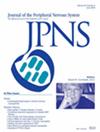Nerve ultrasound in CANVAS-spectrum disease: Reduced nerve size distinguishes genetically confirmed CANVAS from other axonal polyneuropathies
Abstract
Background and Aims
Ultrasound nerve cross-sectional area (CSA) of patients affected with axonal neuropathy usually shows normal value. Cerebellar ataxia, neuropathy and vestibular areflexia syndrome (CANVAS) seems to represent an exception, showing smaller CSA, but previous reports did not test for biallelic RFC1 gene repeat expansions.
Methods
We compared nerve CSA from CANVAS patients (tested positive for biallelic RFC1 gene repeat expansions) with the CSA from a group of patients with chronic idiopathic axonal polyneuropathy (CIAP) who tested negative for RFC1 gene repeat expansions, hereditary axonal neuropathy (Charcot-Marie-Tooth type 2, CMT2), and Friedreich ataxia (FRDA).
Results
We enrolled 15 CANVAS patients (eight men, mean age 66.3 ± 11.5 years, mean disease duration 9.3 ± 4.1 years), affected with sensory axonal neuronopathy. Controls consisted of 13 CIAP (mean age 68.5 ± 12.8 years, seven men), seven CMT2 (mean age 47.9 ± 18.1 years, four men), 12 FRDA (mean age 33.7 ± 8.8, five men). Nerve ultrasound was performed at median, ulnar, sciatic, sural, and tibial nerves and brachial plexus, bilaterally. The nerve CSA from CANVAS patients was significantly smaller than the one from the other cohorts at several sites with significant and high accuracy at Receiver-operating characteristic (ROC) curve analyses. RFC1 AAGGG pentanucleotide expansion, disease duration, and disability did not correlate with CSA at any site, after Bonferroni correction.
Interpretation
Decreased sonographic nerve sizes, in arms and legs, in patients with sensory neuropathy and normal motor conduction studies could point to CANVAS-spectrum disease and help guide appropriate genetic testing.

 求助内容:
求助内容: 应助结果提醒方式:
应助结果提醒方式:


